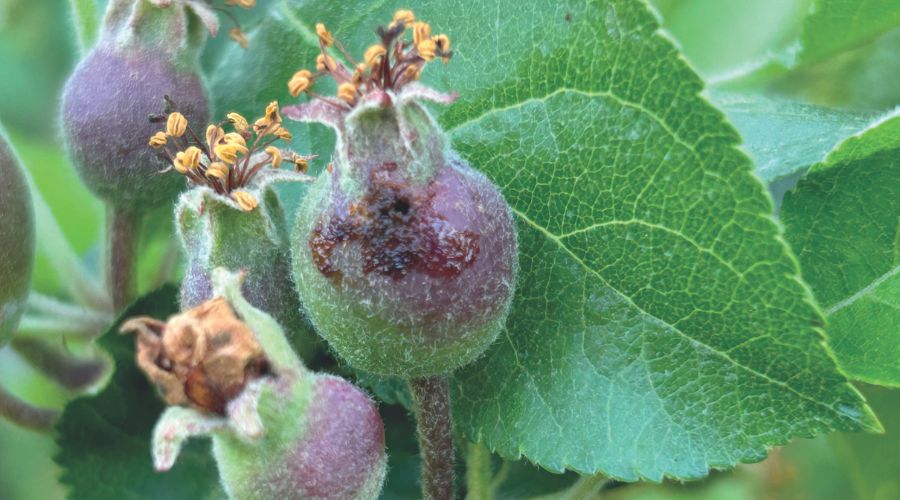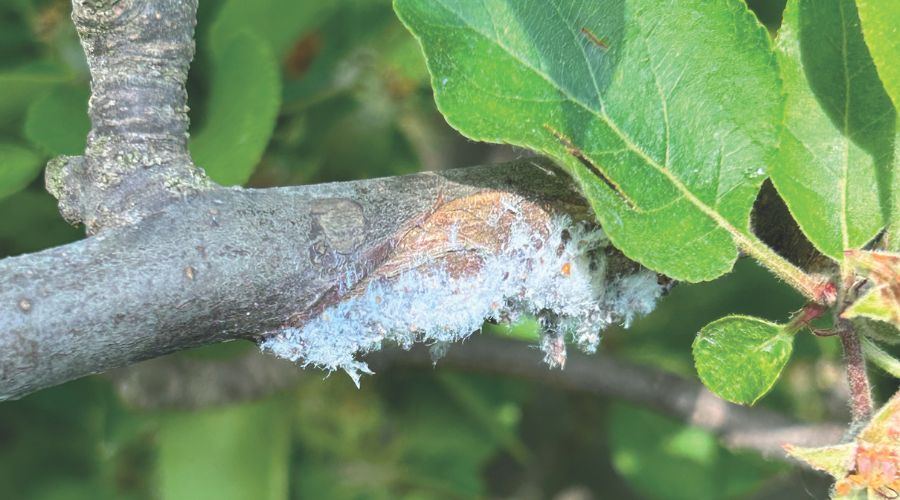Summer management to maintain healthy orchards and vineyards
18th June 2025
Agrovista agronomist Fokion Chatziavgerinos highlights key orchard and vineyard tasks now that summer has arrived.

Apples
Unusually dry conditions kept the risk of apple scab low during the primary season, but secondary scab risk is important from now on. This is triggered by the formation of conidia and conidiospores leading to new infections on leaves and fruit in adjacent areas.
Multiple secondary cycles of scab infection can happen throughout the season whenever we record rain events. Growers should make applications of protectants and after an infection event, if cover is inadequate, they can apply eradicants.
Keep monitoring for rosy apple aphid populations, as levels can still build up in orchards. Woolly aphid assessment during early summer is very important, so no less than 25 trees should be inspected per orchard.
Control is needed wherever woolly aphid has spread to extension growth. Batavia is a good option as it also provides incidental control of rosy aphid populations and other sucking insects, including red spider mite.
A second application may be needed, following the initial application in May. It is worth noting that the naturally occurring parasitic wasp Aphelinus mali helps contain woolly aphids.
Higher temperatures favour spider mite growth. The control threshold is two mites per leaf and it is crucial to encourage natural predators such as earwigs, ladybirds and Typhlodromus predatory mites.
Applications for sawfly control were necessary at the end of petal fall where catches were high. We now need to focus on the risk of codling and tortrix moths.
Traps to monitor flying activity should have been installed during petal fall and we recommend checking the codling models frequently to indicate when applications should be made. Threshold for codling is five moths/trap/week, reducing to three in August, while for tortrix they are 30/week.
Ovicidal products such as Tonus should be applied a few days before predicted egg hatch. A subsequent application of Coragen when egg hatch is predicted to be at its peak will control codling eggs and new larvae. Following that, depending on pest pressure, farms can apply Carpovirusine Cydia granulovirus or opt for other actives if tortrix control is also necessary.

Crop loading in apple orchards
Seasonal crop load adjustment is vital to produce high quality apples of the right size. Various methods can be used such as blossom, fruitlet, and hand thinning.
Following any applications of ATS for blossom thinning and subsequently of Brevis for fruitlet thinning, we need to assess the need for hand thinning.
For best results, discuss application details and hand-thinning requirements with your agronomist.
Optimum thinning results are achieved when performed on a tree-by-tree basis using TreeScout developed by Aurea Imaging. This tractor-mounted sensor assesses blossom density on individual trees, producing maps that ensure thinning is performed only where needed.
Pears
On pears, continue some basic applications for scab control and monitor pear sucker. Control as required when eggs hatch and nymphs emerge and start feeding. Aphids are rarely a problem on pears, but consider controlling if more than two to three clusters per tree are found, to avoid potentially rapid build-up.
Cherries
In cherries, continue monitoring for spider mites and cherry blackflies. SWD control needs to be applied after the straw-colour stage, based on crop risk and pest pressure. Exirel has received an EAMU approval for 2025.
Vines
On vines the risk of downy mildew is set to increase from now on and remain high during the susceptible flowering period, but can still affect crops through the summer.
Frequent checks of Agrovista’s Fruit Insight model will reveal the risk as it considers all the parameters required for infection, and helps fine-tune application timing. If a risk event is confirmed include a systemic eradicant product to achieve a kick-back activity.
Dry conditions also increase the risk of powdery mildew. Appropriate fungicides should be included the spray programme through the season.
It is important to maintain balanced nutrition by including adequate levels of nitrogen, potassium and micronutrients such as calcium, boron and zinc to support flower and fruit development.
Finally, a reminder that you can meet the Agrovista fruit team in person at Fruit Focus, to be held on 9th July at NIAB East Malling.
Agrovista is on stand number 300 and is supporting the event along with partners Botanicoir, ROAM technology, Bato and Koppert.
It is the best time to ask all those questions about substrate and substrate systems, disinfection of growing areas and pollination and biological controls.
This year Botanicoir celebrates 20 years, so please come along and say hello and celebrate with the team.
For more information on Fruit Focus event, see the fruit and vine events pages.

About our expert
Fokion Chatziavgerinos joined Agrovista’s highly regarded team of fruit specialists in 2021, advising on tree fruit and vines across England and Wales.
Key interests include integrated pest management, plant pathology, fruit tree nutrition and fruit crop physiology.
Read more fruit news.
